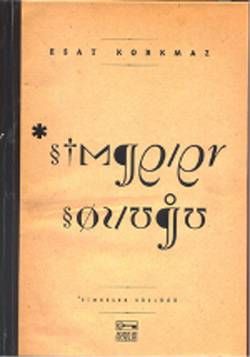
Simgeler Sözlüğü
Symbole haben auch einen „Zweck“: gegen die Irreversibilität der Zeit „zu rebellieren“ und den Menschen zum Beginn der Götter und mythischen Helden zu „tragen“, die Vergangenheit „einzufangen“ und die Zukunft zu „etablieren“. Die meisten von ihnen erscheinen uns als identifizierte Formen des „Nichts“, die „im System der Ausbeutung nicht konsumiert werden können“, deren Identität „in ihrem Schweigen verborgen“ ist und die sich zu gegebener Zeit zum Ausdruck bringen werden. Es handelt sich um komplexe „kulturelle Realitäten“, die erklären, wie etwas entstanden ist und wie es gepflegt und gewachsen ist. In gewisser Weise sind es die Buchstaben des „Code-Alphabets“, das es allem ermöglicht, mit Menschen oder „Kindern des Nichts“ zu „sprechen“; Wenn sie in die Tat umgesetzt, also aktualisiert werden, „nehmen sie die Härte aus dem Leben“ und machen die Welt für uns „lebenswerter“.
Das individuelle Wesen des Menschen liegt „in“ ihm selbst, aber um es zu erkennen, ist es notwendig, dass er eine „objektive“ Beziehung zu seinem Äußeren eingeht; denn das individuelle Wesen lässt sich im objektiven Verhältnis „lesen“: Auf diese Weise „trägt sich das individuelle Wesen zum gesellschaftlichen Wesen“: Um nicht „ignoriert“ zu werden, aktualisiert sich das gesellschaftliche Wesen in Form eines „ Symbol“ mit emotionalen und gedanklichen Zuständen wie Liebe, Schmerz, Freude usw. Es ist eine „unleugbare“ Sozialität.
Der Mensch, der nichts besitzt, lernte zunächst, seine eigene „Existenz“ zu tragen; Dann entschlüsselte er mit den Sinnen die Sprache der Natur, also die „Sprache der Symbole“: Er sah „Liebe“ in der Klarheit des Himmels und „Angst“ in seiner Schwärze. Er suchte nach „Weisheit“ im Auf- und Absteigen des Windes, im Funkeln der Sterne und im Wechsel von Tag und Nacht. Er entdeckte Symbole in jedem von der Natur erzeugten Klang; Er gelangte in allen Symbolen zum „Geheimnis“ des Wortes. Als sie das Universum in einen „kleinen Punkt“ und sich selbst als „Geber“ verwandelten, den sie als kleinen Punkt wahrnahmen, erzeugten sie Wahrheit aus der „unendlichen Leere“ oder dem Wesen der Wesen.
Auf der Suche nach der Wahrheit lernte er, dass „Existenz und Nichtexistenz dasselbe sind oder dass Gut und Böse gleich sind“.
Wenn Sie sich vom Leben entfernen, meidet Sie das „Symbol“; „Nichts“ verspottet dich; Wenn das Leben sein eigenes Spiel spielt, bringt das „Nichts“ Symbole hervor und beobachtet seine eigene Zukunft; Das Spiel des Lebens ist größtenteils eine „Tragödie“, die auf einer Bühne gespielt wird, umgeben vom „Tod“. In dieser Tragödie ist jedes Symbol ein Ast, an dem man sich festhalten kann.
Anzahl der Seiten: 1339
Druckjahr: 2010
Sprache: Türkisch
Herausgeber: Key Books,
Erstdruckjahr: 2010,
Seitenanzahl: 1339,
Sprache: Türkisch
| Yayınevi | : | Anahtar Kitaplar |
| ISBN | : | 9789758612567 |
| Dil | : | Türkçe |


